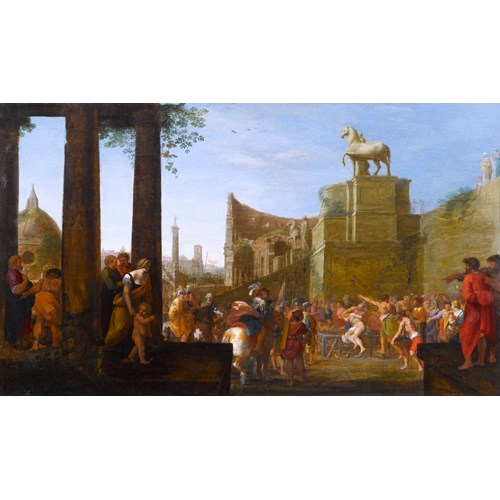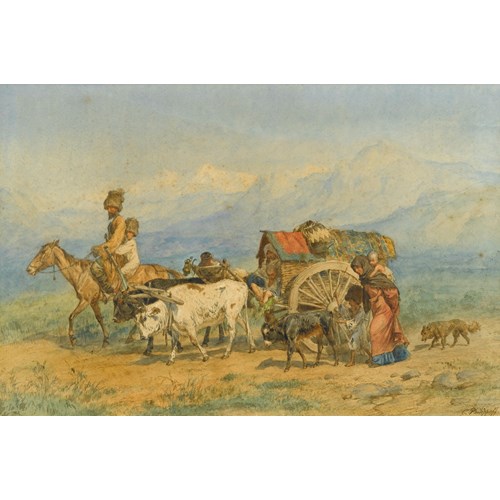Marketplace
Figures on a path by the Thames
John Varley
Figures on a path by the Thames
Period 1750-1850, 18th century
Origin England
Medium Watercolour on paper
Dimension 8.5 x 13 cm (3³/₈ x 5¹/₈ inches)
In this small and charming watercolour a man has paused to talk to two women, whom he has come across on his walk, and his dog waits patiently on the path ahead. They are standing outside a small house, which looks as weathered as the nearby tree straining in the wind. The viewer’s eye is led along the path into the distance where people are sailing and fishing along the tranquil waters of the River Thames. Despite the visibly gusty conditions, the scene is illuminated by soft, warm sunshine. John Varley has built up the scene using layers of colour, executed in rapid, loose brushstrokes. Figures on a Path by the Thames exemplifies the qualities of ‘clear skies, distances, and water’ which Varley described as ‘the beauties most sought after in the art of water colours’.¹
Varley was one of the most successful and prolific watercolourists of his generation, and the present work is characteristic of his best work, as can be seen in a comparison with a picture such as the Victoria and Albert Museum’s Landscape with a Cluster of Cottages behind Trees on the Bank of a Stream. The works share similar features, such as the calm stretch of water, gnarled aged trees and a bright blue sky, across which drift wispy clouds. Into these peaceful and idyllic scenes Varley paints carefully placed, but generalised staffage in order to animate his diminutive landscapes. In both works we can see how Varley allows one colour to dominate the work’s palette, although whereas he uses layers of green in Figures on a Path by the Thames, in the V & A’s work it is autumnal browns which dominate. Varley’s technique is surmised by Storey, who says ‘His tints are refreshingly light, with a full and free pencil; and his colour is fresh and pure...seldom indeed do we find a man better versed in the rules of composition, which he applied with the aptitude of true genius’.²
Varley worked primarily as a watercolourist throughout his career, and he drew inspiration from a variety of other artists, including Thomas Girtin (1775-1802) and John Robert Cozens (1752-1798). He also came into the circle of Dr Thomas Munro, whose tutelage and patronage had such a profound effect on English watercolourists of this period.
Varley’s landscapes range from general views, to more specific topographical scenes, but the River Thames, which the present work depicts, ‘was always a favourite resort of his’.³ Invariably his works exude a sense of quiet contemplation, achieved through his use of multiple layers of wash. Early in his career he exhibited at the Royal Academy, but he was also a founding member of the Society of Painters in Water Colours. He was also a gifted teacher, noted for his enthusiasm, and he wrote several books on drawing, aimed at the amateur, which laid out rules for composition and explained the value of tints, amongst other things. Although in later life he struggled with his debtors, Varley’s contribution to British watercolour painting was immense and Figures on a Path by the Thames is an excellent example of his work.
1 Story, Alfred T., James Holmes and John Varley (Richard Bentley and Son, London, 1894), p. 220.
2 Ibid., p. 282-283.
3 Ibid., p.214.
Varley was one of the most successful and prolific watercolourists of his generation, and the present work is characteristic of his best work, as can be seen in a comparison with a picture such as the Victoria and Albert Museum’s Landscape with a Cluster of Cottages behind Trees on the Bank of a Stream. The works share similar features, such as the calm stretch of water, gnarled aged trees and a bright blue sky, across which drift wispy clouds. Into these peaceful and idyllic scenes Varley paints carefully placed, but generalised staffage in order to animate his diminutive landscapes. In both works we can see how Varley allows one colour to dominate the work’s palette, although whereas he uses layers of green in Figures on a Path by the Thames, in the V & A’s work it is autumnal browns which dominate. Varley’s technique is surmised by Storey, who says ‘His tints are refreshingly light, with a full and free pencil; and his colour is fresh and pure...seldom indeed do we find a man better versed in the rules of composition, which he applied with the aptitude of true genius’.²
Varley worked primarily as a watercolourist throughout his career, and he drew inspiration from a variety of other artists, including Thomas Girtin (1775-1802) and John Robert Cozens (1752-1798). He also came into the circle of Dr Thomas Munro, whose tutelage and patronage had such a profound effect on English watercolourists of this period.
Varley’s landscapes range from general views, to more specific topographical scenes, but the River Thames, which the present work depicts, ‘was always a favourite resort of his’.³ Invariably his works exude a sense of quiet contemplation, achieved through his use of multiple layers of wash. Early in his career he exhibited at the Royal Academy, but he was also a founding member of the Society of Painters in Water Colours. He was also a gifted teacher, noted for his enthusiasm, and he wrote several books on drawing, aimed at the amateur, which laid out rules for composition and explained the value of tints, amongst other things. Although in later life he struggled with his debtors, Varley’s contribution to British watercolour painting was immense and Figures on a Path by the Thames is an excellent example of his work.
1 Story, Alfred T., James Holmes and John Varley (Richard Bentley and Son, London, 1894), p. 220.
2 Ibid., p. 282-283.
3 Ibid., p.214.
Period: 1750-1850, 18th century
Origin: England
Medium: Watercolour on paper
Signature: Signed ‘J Varley’ (lower right)
Dimension: 8.5 x 13 cm (3³/₈ x 5¹/₈ inches)
More artworks from the Gallery









